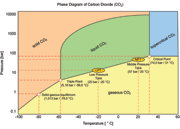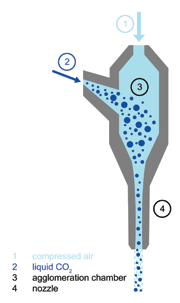E-Archive
Articles
in Vol. 9 - January Issue - Year 2008
CO2-Blasting Processes, Applications And Current Developments

Figure 1: Phase chart of CO2

Figure 2: pure CO2-snow balsting (CO2 Snow Jet Cleaning)

Figure 3: Expansion into ambient pressure (2-media ring nozzle)

Figure 4: Expansion into blasting pressure (with agglomeration chamber)
Due to two advantages the blasting with solid carbon dioxide has been established in various areas of applications. On the one hand the low hardness of carbon dioxide (less than 2 Mohs) allows work on a wide spectrum of materials. On the other hand no blasting abrasive or cleaning agent has to be removed after the cleaning process, because the carbon dioxide sublimates completely at ambient pressure without any residues. Only the removed contamination or coating has to be disposed of. Carbon dioxide is an odourless and colourless gas, which is generated for example during combustion and breathing processes. At ambient pressure and depending on the temperature, it is either gaseous or solid, see figure 1.
Mechanism of blasting with solid CO2
Unlike other blasting processes, not only the mechanical impact influences the cleaning success, there are three specific effects that characterise blasting with solid CO2. Firstly, the low temperature of 78.5 °C causes thermal tensions between the base material and the contamination or coating. The cooling of the surface may also embrittle and crack the coating. Secondly, the impact of the CO2 particles at high speed causes a mechanical separation which is enforced by the third effect, the pressure surge caused by the instantaneous sublimation of the CO2-particles. The contamination is removed from the surface by the mechanical impulse that is transmitted by the CO2-particles and in addition by the aerodynamic forces of the CO2-gas and the compressed-air jet. The flow caused by the compressed-air jet might lead to an unwanted cross-contamination. Therefore, dependent on the application, the removed particles should be exhausted near the surface.
Manufacturing of dry ice
In principle there are two different ways of blasting with solid carbon dioxide: either by using the solid phase or by using the liquid phase of CO2. Usually the first principle is called Dry Ice Blasting and the second CO2-Snow Blasting. Dry Ice Blasting uses rice grain-sized dry ice particles - so called pellets - as blasting medium. The pellets are manufactured in a separate process and then filled into the blasting plant. The acceleration of the particles is implemented by a compressed air flow. Here mostly nozzles with Laval-geometry are used. The blasting of dry ice with a rotating wheel is in development. As an advantage of this procedure cost-intensive compressed-air generation and processing is not necessary.
The blasting abrasives (pellets) for the dry ice blasting are produced in separate process. Liquid CO2 stored in a tank at 57 bar is expanded into ambient pressure. During the expansion the liquid CO2 cools down due to the Joule-Thomson-effect to 78.3 °C, simultaneously a phase change takes place. After the expansion, the CO2 exists approx 40 % in solid form as CO2 snow particles. The remaining CO2 changes into the gaseous phase and may be re-condensed. Instead of producing the dry ice oneself, it can also be bought from dry ice suppliers or gas companies. In Germany the network of suppliers is tight, so a delivery of high quantities overnight is possible. The dry ice can be stored a couple of days in insulated storage containers. The storage of dry ice however is not without problems. Besides the loss of mass due to permanent sublimation the dry ice changes its properties because of its hygroscopic behaviour. For automation of the process a so-called Inline-pelletizer was newly developed. With this technique it is possible to produce pellets during the process, without storage or manual proportioning of the blasting abrasive.
CO2-snow blasting
For CO2-Snow Blasting the CO2 is stored under pressure in its liquid form. The described gas expansion, which yields a mixture of CO2 snow and gas, is part of the blasting process. The snow-gas-mix is usually accelerated by a compressed air flow afterwards. Basically there are three different principles of snow blasting: pure CO2-Snow Blasting (figure 2), using a 2-media ring nozzle (figure 3) and using an agglomeration chamber (figure 4).
The low-abrasive CO2 Snow Jet Cleaning is a pure CO2 Blasting procedure without any separate compressed air acceleration, but with simple installation construction. The liquid carbon dioxide is exposed to ambient pressure at the nozzle exit and then accelerated by CO2 flow. A little more abrasiveness performs the 2-media ring nozzle technology. Liquid carbon dioxide is also exposed to ambient pressure at the nozzle exit. There, CO2 snow particles are focused and accelerated by a supersonic compressed annular ring flow.
The third and most abrasive CO2-Snow Blasting technology uses an agglomeration chamber for the formation of carbon dioxide snow. The expansion room is followed directly by a nozzle which is used to accelerate the particles.
Since the blasting medium is continuously fed to the process and the blasting devices are nearly wear-free CO2-Snow Blasting is in general very suitable for automation.
Example of applications
As a result of the varied properties of the CO2-blasting techniques, they cover a wide range of applications. The CO2 Snow Jet Cleaning for example is used for the micro-cleaning of optical and electrical components. The technique with the two-component-concentric-nozzle was originally designed for similar areas of application. By developing nozzles which are connected in series, the so-called nozzle-arrays, a higher area-performance could be achieved. Therefore it is also interesting for the pre-treatment before varnishing. In comparison to the other CO2-blasting techniques these two techniques have the advantage of a moderate sonic-generation. The generation of noise is one of the main disadvantages during blasting with solid CO2. The higher abrasiveness when using the agglomeration chamber and the higher area-performance makes this technique particularly suitable for applications where a pre-treatment before varnishing or the automated cleaning of tools and moulds is necessary. The CO2 blasting is a dry process where no cleaning medium arises. Therefore a cleaning is possible without demounting and if necessary parallel to the primary processing time. Another side-effect is the additional cooling of tools by the cold CO2 and the chip removal during metal-cutting manufacturing. Bad processing-quality, reduced tool lifetime and the risk of broken dies can be avoided when using CO2-Snow Blasting as coolant. If there is a need of higher abrasiveness or a higher flexibility in the manual process with a wide parameter-range, the dry ice blasting comes into operation.
Summary / Prospects
Blasting with solid carbon dioxide as an environment-neutral cleaning process is an alternative in various sectors. This technique is very flexible in terms of contaminations and substrate. The most important advantage during blasting with carbon dioxide is that no secondary contamination has to be removed and that sensitive surfaces can be cleaned without damage. However due to the blasting character only visible surfaces can be machined.
To expand the field of applications of cleaning with CO2 beyond the blasting, presently an alternative to the wet chemical cleaning will be developed. In the liquid and especially in the supercritical state (figure 1), CO2 has solvent properties and is highly qualified as a cleaning agent for the removal of organic contamination. The cleaning effect of supercritical CO2 is known from the high-pressure extraction of e.g. caffeine and spices. The big advantage of this cleaning technique is that neither rinsing nor drying of parts is necessary after the cleaning process. This makes the technique predestined for the cleaning of scooping or porous parts and bulk materials. The CO2 will expand after the cleaning process into gas and recondenses. The cleaning medium and if required also the contamination like machine oil can be retrieved as new.
The Fraunhofer IPK assists interested parties with the selection of the most efficient cleaning technology and its integration into existing manufacturing processes. The services range from consulting, conducting feasibility studies, parameter and system optimization, to the development of new products to comprehensive research projects. The conference on Dry Ice Blasting, which is organised by the IPK, offers a forum for the exchange of ideas and experiences as well as socialising and networking. The participants are service providers, end users, blasting equipment manufacturers, gas suppliers and research facilities.
Fraunhofer IPK Berlin, Germany
For information:
Tel.+49.30.3 90 06–1 47
E-mail: martin.bilz@ipk.fraunhofer.de
www.ipk.fraunhofer.de
www.strahlverfahren.de/eng




























